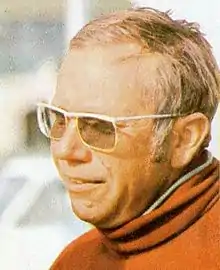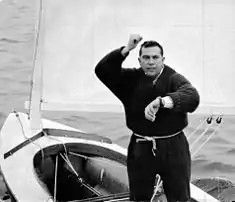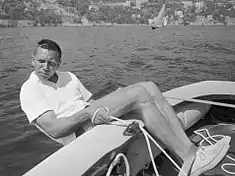Paul Elvstrøm
Paul Bert Elvstrøm (25 February 1928 – 7 December 2016) was a Danish yachtsman. He won four Olympic gold medals and twenty world titles[3] in a range of classes including Snipe, Soling, Star, Flying Dutchman, Finn, 505, and 5.5 Metre. For his achievements, Elvstrøm was chosen as "Danish Sportsman of the Century."[4]
 Elvstrøm c. 1972 | |||||||||||||||||||||||||||||||||||||||||||||||||||||||||||||||||||||||||||||||||||||||||||||||||
| Personal information | |||||||||||||||||||||||||||||||||||||||||||||||||||||||||||||||||||||||||||||||||||||||||||||||||
|---|---|---|---|---|---|---|---|---|---|---|---|---|---|---|---|---|---|---|---|---|---|---|---|---|---|---|---|---|---|---|---|---|---|---|---|---|---|---|---|---|---|---|---|---|---|---|---|---|---|---|---|---|---|---|---|---|---|---|---|---|---|---|---|---|---|---|---|---|---|---|---|---|---|---|---|---|---|---|---|---|---|---|---|---|---|---|---|---|---|---|---|---|---|---|---|---|---|
| Full name | Paul Bert Elvstrøm | ||||||||||||||||||||||||||||||||||||||||||||||||||||||||||||||||||||||||||||||||||||||||||||||||
| Nationality | Danish | ||||||||||||||||||||||||||||||||||||||||||||||||||||||||||||||||||||||||||||||||||||||||||||||||
| Born | 25 February 1928 Hellerup, Denmark[1] | ||||||||||||||||||||||||||||||||||||||||||||||||||||||||||||||||||||||||||||||||||||||||||||||||
| Died | 7 December 2016 (aged 88) Hellerup, Denmark[2] | ||||||||||||||||||||||||||||||||||||||||||||||||||||||||||||||||||||||||||||||||||||||||||||||||
| Height | 1.82 m (5 ft 11+1⁄2 in) | ||||||||||||||||||||||||||||||||||||||||||||||||||||||||||||||||||||||||||||||||||||||||||||||||
| Weight | 85 kg (187 lb) | ||||||||||||||||||||||||||||||||||||||||||||||||||||||||||||||||||||||||||||||||||||||||||||||||
| Sailing career | |||||||||||||||||||||||||||||||||||||||||||||||||||||||||||||||||||||||||||||||||||||||||||||||||
| Class(es) | 5.5 Metre, 505, Finn, Firefly, Flying Dutchman, Snipe, Soling, Star, Tornado | ||||||||||||||||||||||||||||||||||||||||||||||||||||||||||||||||||||||||||||||||||||||||||||||||
| Club | Hellerup Sejlklub, Gentofte | ||||||||||||||||||||||||||||||||||||||||||||||||||||||||||||||||||||||||||||||||||||||||||||||||
Medal record
| |||||||||||||||||||||||||||||||||||||||||||||||||||||||||||||||||||||||||||||||||||||||||||||||||


Early life
Paul Elvstrøm was born, north of Copenhagen, in a house overlooking the sound between Denmark and Sweden. His father was a sea captain but died when Elvstrøm was young, and he was brought up by his mother along with a brother and sister. A second brother drowned at the age of 5 when he fell off a seawall near the family home.[5]
Growing up along the Øresund, Elvstrøm quickly became consumed by sailing, which began with crewing in a club fleet of small clinker keelboats. He was soon given an Oslo dinghy by a neighbour who realised Elvstrøm's mother was too poor to be able to buy one.[5]
In his book Elvstrøm Speaks on Yacht Racing he claimed to be ‘word blind’ and could not read or write when he was at school,[5] which may have been due to dyslexia.[6] It is clear that Elvstrøm considered schooling a distraction from sailing: "I was very bad in school," he said, "The only interest I had was in sailing fast…The teacher knew that if I was not at school, I was sailing."[5]
After leaving school he became a member of the Hellerup Sailing Club, where he gained a reputation as an excellent sailer. He was funding himself during this period as a bricklayer, but in 1954 also started cutting sails for club members in his basement.[7]
Innovation
Elvstrøm was noted as a developer of sails and sailing equipment. One of his most successful innovations was a new type of self-bailer. The new features were a wedge shaped venturi that closes automatically if the boat grounds or hits an obstruction, and a flap that acts as a non return valve to minimise water coming in if the boat is stationary or moving too slowly for the device to work. Previous automatic bailers would be damaged or destroyed if they met an obstruction, and would let considerable amounts of water in if the boat was moving too slowly.[8]
The Elvstrøm self-bailer is still in production under the Andersen brand and has been widely copied; it is still found on Olympic boats, and other grand prix boats at the leading edge of the sport.[9] In 2016, Dan Ibsen, the executive director of the Royal Danish Yacht Club said, “Today the Elvstrøm Bailer is still the only functional bailer on Olympic dinghies and boats around the world.”[10]
Other innovations include the Elvstrøm Lifejacket, which was the first specifically designed and produced for active sailors.[9]
He also popularised the kicking strap, or boom vang (US).[11] This may take the form of a block and tackle linking a low point on the mast (or an equivalent point on the hull) and the boom close to the mast, which allows the boom to be let out when reaching or running without lifting. This controls the twist of the mainsail from its foot to its head, increasing the sail's power and the boat's speed and controlability. Elvstrøm did not advertise his new invention, leaving his competitors mystified at his superior boat-speed. Investigation of his dinghy revealed nothing as he used to remove the kicking strap before coming ashore.[12]
Among the innovative concepts he brought to sailboat racing was the concept of gates instead of a single windward or leeward mark in large regattas. The leeward gate on a windward-leeward course is commonly used. The windward gate is less often used due to the difficulties in managing right-of-way around the right gate, the subtleties of which are understood mostly by match racers.[13] He has also been instrumental in developing several international yacht racing rules.
Training
Elvstrøm was a very early innovator in training techniques. For example, he used the technique of 'sitting out' or hiking using toe-straps to a greater degree than previously, getting all his body weight from the knees upwards outside the boat, thus providing extra leverage to enable the boat to remain level in stronger winds and hence go faster than his competitors. This technique required great strength and fitness, and so after the 1948 Olympics, in order to improve his physical conditioning in readiness for the 1952 games,[14] Elvstrøm built a training bench with toe-straps in his garage to replicate the sitting-out position in his dinghy. He then proceeded to spend many training hours on dry land sitting out on the bench at home.
“He did take sailing to a level that you had to call it a sport,” said Jesper Bank, a principal at Elvstrom Sails and a two-time Olympic gold medalist for Denmark. “Before Paul, you would see competitors with pipes in their mouths and wearing skippers’ caps. At that time, they certainly thought he was superhuman.”[10]
According to an obituary by the International Finn Association, "He was a sportsman and the first real sailing athlete. He trained harder and longer than anyone else so that when the day of the race came he was better prepared than anyone else. He was famous for his physical strength and fitness, able to out-hike anyone on the race course.”[14]
Business
Elvstrøm established a manufacturing company, Elvstrøm Sails, whose products included masts, booms, and sails. Displaying a keen marketing mind to go along with his engineering nous, the business grew rapidly and by the 1970s Elvstrøm products were seen on boats all around the world.[10]
Personal life
Elvstrøm was married to Anne, who pre-deceased him by three years; together they had four daughters: Pia, Stine, Gitte and Trine.[10]
Elvstrøm continued to sail in his later years until Parkinson's disease began to afflict him. In 2009 he sailed his Dragonfly trimaran — solo — to visit his daughter Gitte and her family on the east coast of Sweden, 600 miles from his home.[10]
Elvstrøm's success and celebrity brought personal stress. At the 1972 Games in Munich, under the pressures of competition and his challenges facing his sail-making business, he suffered a nervous breakdown.[15]
He died on 7 December 2016 at the age of 88,[16] after battling Alzheimers for a few years.
Legacy
As well as being remembered as arguably the greatest sailing racer ever, Elvstrøm was also known to be a model of sportsmanship. He is famous for his philosophy that, "If you, by winning, are losing your friends, you are not winning."[10]
Achievements
Elvstrøm competed in eight Olympic Games from 1948 to 1988, being one of only eight persons ever (the others are sailor Ben Ainslie, swimmer Michael Phelps, wrestlers Kaori Icho and Mijaín López, speed skater Ireen Wüst and athletes Carl Lewis in the long jump and Al Oerter in the discus) to win four consecutive individual gold medals (1948–60), first time in a Firefly, subsequently in Finns.[17] In his last two Olympic games he sailed the Tornado Catamaran class, which, in those days, was normally sailed by two young men, with his daughter Trine Elvstrøm as forward hand.[18]
He is one of only five athletes who have competed in the Olympics over a span of 40 years, along with fencer Ivan Joseph Martin Osiier, sailors Magnus Konow and Durward Knowles and showjumper Ian Millar.[19]
Elvstrøm won medals at the world championships: Finn, 505, Snipe, Flying Dutchman, 5.5 Metre, Star, Soling, Tornado, and Half Ton.
In 1996, Elvstrøm was chosen as "Danish Sportsman of the Century."[4]
In 2007, Elvstrøm was among the first six inductees into the ISAF Sailing Hall of Fame.[20]
| Year | Competition | Venue | Position | Event | Notes |
|---|---|---|---|---|---|
| 1956 | Finn Gold Cup | 2nd | Finn | [21] | |
| 1957 | 505 World Championships | 1st | 505 | [22] | |
| 1958 | 505 World Championships | 1st | 505 | [22] | |
| Finn Gold Cup | 1st | Finn | [21] | ||
| 1959 | Finn Gold Cup | 1st | Finn | [21] | |
| Snipe World Championship | 1st | Snipe | [22] | ||
| 1962 | Flying Dutchman World Championship | 1st | Flying Dutchman | [22] | |
| 1966 | 5.5 Metre World Championship | 1st | 5.5 metres | ||
| Star World Championship | 1st | Star | [22] | ||
| 1967 | Star World Championship | 1st | Star | [22] | |
| 1969 | Soling World Championship | 1st | Soling | [22] | |
| Star World Championship | 2nd | Star | [22] | ||
| 1971 | Soling World Championship | 3rd | Soling | ||
| 1972 | Half Ton Cup / World Championship | 1st | Half Ton | [23] | |
| 1974 | Soling World Championship | 1st | Soling | [22] | |
| 1985 | Tornado World Championship | 3rd | Tornado | [22] | |
| 1981 | Half Ton Cup / World Championship | 1st | Half Ton | [24] |
Bibliography
- Elvstrom, Paul. Expert Dinghy and Keelboat Racing, 1967, Times Books, ISBN 0-8129-0054-5
- Elvstrom, Paul. Elvström Speaks on Yacht Racing, 1970, One-Design & Offshore Yachtsman Magazine, ISBN 0-8129-0134-7
- Elvstrom, Paul. Elvström Speaks -- to His Sailing Friends on His Life and Racing Career, 1970, Nautical Publishing Company, ISBN 0-245-59851-0
- Paul Elvström Explains the Yacht Racing Rules, First edition 1969, title updated to Paul Elvstrom Explains the Racing Rules of Sailing: 2005–2008 Rules. Updated four-yearly in accordance with racing rules revisions, various authors and publishers. ISBN 0-07-145626-0
See also
References
- "Eight Bells: Paul Elvstrom". 7 December 2016. Retrieved 8 December 2016.
- "Han vandt fire OL-guldmedaljer: Sejleren Paul Elvstrøm er død" (in Danish). Berlingske Tidende. 7 December 2016. Retrieved 8 December 2016.
- "Paul Elvstrøm - Elvstrøm Sails".
- Albrechtsen, Karin; Leksikon, Gyldendal. "Paul Elvstrøm". Denmark.dk. Retrieved 16 January 2018.
- "The Great Dane dies at 88 + Video". www.sail-world.com. Retrieved 6 December 2020.
- "Paul Elvström, Sailing's Greatest". www.sail-world.com. Retrieved 6 December 2020.
- Museler, Chris (9 December 2016). "Paul Elvstrom, 88, Olympian Who Powered Sailing by Leaning Over Waves (Published 2016)". The New York Times. ISSN 0362-4331. Retrieved 6 December 2020.
- Egan, Martin. "Self Bailers". www.ukmirrorsailing.com. Retrieved 14 December 2020.
- "Paul Elvström". sailing.org. Retrieved 14 December 2020.
- Museler, Chris (9 December 2016). "Paul Elvstrom, 88, Olympian Who Powered Sailing by Leaning Over Waves (Published 2016)". The New York Times. ISSN 0362-4331. Retrieved 14 December 2020.
- "Paul Elvstrom • The Daily Dose". The Daily Dose. 6 November 2015. Retrieved 14 December 2020.
- "Olympic Diaries: Paul Elvstrøm >> Scuttlebutt Sailing News". Scuttlebutt Sailing News. 20 January 2020. Retrieved 14 December 2020.
- "Scuttlebutt: Archived Newsletters". Retrieved 13 August 2008.
- "Paul Elvstrøm - The legacy defines the man". finnclass.org. Retrieved 14 December 2020.
- "Paul Elvstrom | Biography, Olympic Medals, & Facts". Encyclopedia Britannica. Retrieved 14 December 2020.
- Andersen, Jens (7 December 2016). "Paul Elvstrøm er død". dr.dk (in Danish). DR. Retrieved 7 December 2016.
- "International Olympic Committee – Athletes". Retrieved 13 August 2008.
- Evans, Hilary; Gjerde, Arild; Heijmans, Jeroen; Mallon, Bill; et al. "Paul Elvstrøm". Olympics at Sports-Reference.com. Sports Reference LLC. Archived from the original on 25 September 2015.
- Glenday, Craig (29 November 2018). Guinness World Records 2012. Bantam Books. ISBN 9780345534378 – via Google Books.
- "ISAF Hall of Fame : Paul Elvström". Archived from the original on 17 September 2008. Retrieved 13 August 2008.
- "Finn World Championships". the-sports.org. Retrieved 20 April 2012.
- "Paul Elvstrøm – Results". sailing.org. Retrieved 21 April 2012.
- "SailboatData.com - BES 1/2 TON Sailboat". sailboatdata.com.
- "Пауль Эльвстрем — чемпион мира 1981 года среди «полутонников» (Спорт / Новости спорта) - Barque.r"".
External links
![]() Media related to Paul Elvstrøm at Wikimedia Commons
Media related to Paul Elvstrøm at Wikimedia Commons
- Paul Elvstrøm at World Sailing
- Paul Elvström, Sailing's Greatest at Sail-World.com
- Paul Elvstrøm at Olympics.com
- Paul Elvstrøm at OlympicChannel.com (archived)
- Paul Elvstrøm at Olympedia